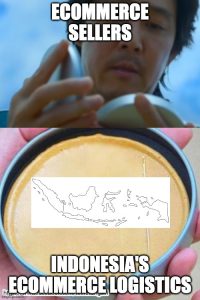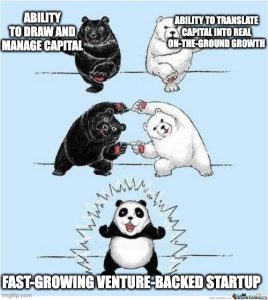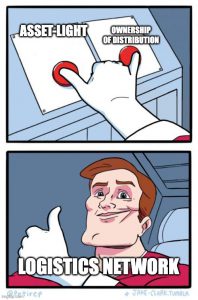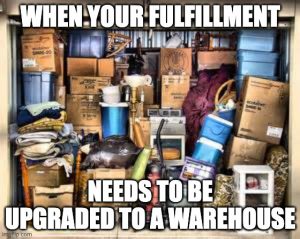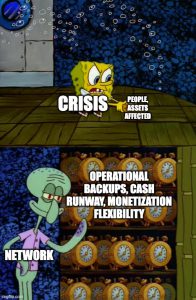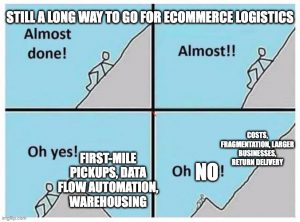Highlights:
- “Invest your time in people who are genuine, invest in your resources and time and people who will create more value and are driven towards the same mission, don’t try to cut corners on people.” – Phil Opamuratawongse
- “A lot of the tech is actually built to suit offline needs. Otherwise, if we assume that whatever we design as a software [we implement] without [considering] the physical or offline experience, it will not work very well from our experience.” – Budi Handoko
- “We have this agent network…working with them is fascinating because all these agents are basically micro-entrepreneurs and we slowly become their main source of income.” – Phil Opamuratawongse
- “So everything that we do across the value chain, it’s a per parcel basis. And that’s extremely important in e-commerce.” – Phil Opamuratawongse
- “Instead of us building the same thing — it’s a waste of time and resources, we thought, “Hey, we should just work together to build that agent network. So, we can save some time and win the market faster.” – Budi Handoko
Last week Shipper celebrated its 4th year anniversary, 4 years since Budi Handoko and his team back in 2017 launched a platform to consolidate the fragmented first-mile 3PL landscape in Indonesia.
Under the leadership of Budi and his co-founder and CEO Phil Opamuratawongse, this platform has since become the largest tech-enabled, first-mile logistics network in the country covering more than 35 cities with thousands of delivery agents and micro-fulfillment hubs and more than 200 warehouses, all connected via proprietary software.
Shipper’s journey thus far is a case study in building physical or people networks enabled by technology. It is a go-to-market and growth strategy which we see frequently in Indonesia, with the likes of Payfazz in fintech, Super in social commerce, or even Lifepal with insurance and Pinhome with property. While the evolution of the company is intuitive in hindsight, a lot of elements had to come together for Shipper’s existing network to be what it is today, from the fully digital solution the company came out with four years ago.
The growth of this digital and physical infrastructure through which Shipper is able to distribute its services from first-mile parcel fulfillment to warehouse management solutions also took place as Indonesia’s ecommerce sector boomed, buffeted by the tailwinds of the pandemic, the rapid expansion of generalist marketplaces from Shopee to Tokopedia to Blibli, and the rise of payment platforms like Ovo and Dana. From 2015 to 2019, Indonesia’s ecommerce GMV grew 10x from US$2 billion to US$21 billion, then increased by 54% a year later.
A video to visually demonstrate Shipper’s network in action
In this article, with the help of the podcasts we’ve had with Budi this year and Phil last year, we dissect Shipper’s approach to building a scalable network-driven business in four years that would have taken other companies years to build, while also tying this infrastructure to the impact the company has had on ecommerce logistics, from reducing fulfillment and warehousing costs for enterprise to growing the businesses of small sellers. In particular we cover 7 elements that were pivotal to enabling Shipper’s rapid growth.
- Leadership and Capital: Networks are not just about infrastructure; it’s also about the confluence of talent and capital.
- Team: Fast-growing networks work best with mission-driven teams and bottom-up culture.
- Technology: Evolve the network’s tech layer to the beat of the offline layer.
- Distribution: Own the network while keeping it asset-light.
- Monetization: Keep monetization flexible to reduce customer concentration risk.
- Growth: Grow the network with the customers.
- Integrity: Secure the network with strategic backups.
- Speed: Expand the network with trust and partnerships.
Networks are not just about infrastructure; it’s also about the confluence of talent and capital
The best venture-backed startup teams are led by a confluence of complementary skill sets and backgrounds, oftentimes a combination of deep industry experience (i.e. how do you solve the problem and generate real growth on top of product-market fit) and hypergrowth expertise (i.e. how do you sustain or even speed up this growth with capital?). Shipper’s founders, Phil and Budi, are a classic example of this, though the story of how they came together was a lot less straightforward than ex-colleagues or friends coming together to start a company.
It all began with Budi in 2016, when he was settling into Indonesia after years in Australia where he had founded several startups, one of which was a payments startup acquired by MOL Malaysia which was then subsequently acquired by Razer. In his first few years back in Indonesia, he was also an ecommerce seller of fashion items.
He shares on our podcast how this experience as an ecommerce seller, as well as an awareness of where ecommerce was going in Indonesia shaped by his own experience in the payments industry, led him to start Shipper. “During that time, in 2015 and 2016, I had problems actually in shipping my own products. I was trying to sell online to ship a particular product. It took me ages then to go to a particular logistics agent and offline store where I need to line up, because there’s actually a long queue. And I believe that there was a [time] even earlier that I had to fill out the paperwork, like just a manual form, just like when you go to the bank and make a deposit or withdrawal.
Imagine that was the situation at that time, and I had to line up for about an hour before I got served, then not to mention the travel time to go back to my house. The whole shipping process actually takes a while. And at that time ecommerce was still growing. It was just getting started, and imagine, if the logistics in Indonesia, if they had to grow 10x or 20x or 100x from there, imagine what will be the logistics backlog or bottleneck, for that to happen.
Because of that, I believed there was a real problem here that we needed to solve. How do we make sure that all the people who actually sell online don’t have any problems in dealing with logistics companies, especially the first mile?…And then how can we actually have a single platform because we are selling from multiple locations? How do we actually track or look at all of the orders from one single platform, which is very important as well? And that’s how Shipper started. We believe that there’s actually something we can build, something meaningful here to solve all those problems.
[Another thing] is that I also believed that with the growth of [ecommerce] there are always two things that follow, one is payments. The other one is logistics. And coming from the payments background, I kind of knew what was going to happen. So I also believed that logistics was not really [addressed] at that time. And I believed I had a real chance to actually solve real problems there.”
Empowered by the opportunity that could be unlocked by solving the challenges faced by ecommerce sellers in Indonesia, Budi and his early team launched Shipper in 2017 as a console aggregating 3PL providers. This caught the eye of Insignia Ventures which had also launched with its maiden fund at that time, and Shipper received its first check from the firm that same year. Around that time, Phil was an ocean away, just beginning his stint at Floodgate after finishing his undergrad studies at Stanford and spending a few years at McKinsey.
Phil shares on our podcast what he learned from immersing himself in the Bay Area’s startup ecosystem through early-stage venture capital. “I grew up in Thailand but moved to the Bay Area pretty early in my childhood. I finished my undergrad there at Stanford, moved on and through all the way to working at Floodgate. It was transformative in many ways. My biggest takeaway there was simply anything’s possible. And to give you a little light on the Bay Area and my time there, it’s an environment where it really promotes entrepreneurship and crazy ideas.
There aren’t many places in the world where college dropouts and fresh grads can raise millions of dollars, right, to try new things. They’re also not many places in the world where you talk about technology 24/7 because that’s where the majority of the workforce works. So being submerged in that environment did help a lot, but I think the inspiration and confidence really came from my time at Floodgate and investing in crazy entrepreneurs.
We were investing seed, pre-seed very similar to you, Yinglan, where you invest in entrepreneurs before anyone else believes. I think even in Southeast Asia, there are not many like that, and I think Insignia is one of the true ones who do that. Being at Floodgate and doing that multiple times, investing in entrepreneurs before anyone believed, it helped me see many different types of entrepreneurs walk through the doors, from young to old, very diverse race, every type of idea you can think of. So having that repetition and having that experience really did help. On the flip side, especially towards my second year at Floodgate. I had my teammates at Floodgate pushing me out of the door to try something myself. I mean, that also was very inspirational and positive.”
Phil eventually left Floodgate to try out something for himself, and he decided the best place to do that was not in the Bay Area, but back home in Southeast Asia. He shares three reasons on our podcast.
“There are a few reasons. I’ll name three specifically. The first reason is coming to Indonesia or Southeast Asia broadly, my family’s from Southeast Asia. They’re right around the corner in Bangkok. I spent significant time here during my childhood. So that was definitely a push for me. But speaking of family, I think, Budi Handoko, who is my partner on this journey to build Shipper. You know I consider him family and he was also a big push as well in that kind of family bucket. You see, I had the support from my family, including Budi as well, people who I trust, people who I can really trust in embarking this journey so that gave me the confidence in doing this.
Second is I think it’s a world where a lot of impact can still be created. It’s still so early in the emerging markets. And there’s so much that technology can do, even for many technology companies in more mature markets, the next billion users are right here. They’re not in the mature markets anymore. If you go to these big technology companies and ask where your next source of revenue is, it’s the next billion users, Indonesia being a big part of that. And it’s extremely difficult to crack. So I think it’s important to be in the region to try to solve those problems.
The third piece is going back to the ecosystem and support and knowing that there was an ecosystem and there are folks like Insignia who supported entrepreneurs was a big draw for me, you know, I felt like there are always people who I can rely on and lean back and get support from if anything ever happened. And they had the same mission and vision as us in terms of building technology ecosystems. So I think those were the three big reasons. Yeah. I mean, it’s been a great ride so far.”
When Phil returned to Southeast Asia in 2018, he joined Insignia Ventures as an Entrepreneur-in-Residence to brainstorm on the next big problems to solve in the region, and his interest lay in logistics and supply chain management. Already an Insignia portfolio founder, Budi was one of the founders Phil met as he looked for problems to solve, and since then, the two partnered up to take Shipper to the next level.
Both Phil and Budi were returnees who saw immense potential in Indonesia through different lenses. One was cultivated by the experience of growing several tech startups in payments and commerce and the pain points of being an ecommerce seller. The other was formed by exposure to numerous early-stage startups in Silicon Valley and a mission to create impact in the next billion users in Southeast Asia.
By the time Phil joined Shipper, the company was already riding Indonesia’s ecommerce wave, helping SMEs and small sellers to do their first-mile fulfillment and ship products through a combination of online platform and offline agent network. But bringing their lenses together as co-founders unlocked new capital-fuelled growth for Shipper’s network.
Shipper joined Y Combinator a year later, and successively raised their seed through Series B rounds (a total of US$88 million) in less than two years. The company also launched its warehousing business, scaling the reach of its network immensely and opening up new customer segments by meeting enterprise-level pain points in first-mile fulfillment.
Budi enumerates these milestones in a Linkedin post about his inclusion into Tatler Asia’s Gen T 2021 List. “It was 2017 and I still remember clearly when Yinglan Tan [from] Insignia Ventures Partners wrote the first check of $350,000 for us, someone pretty new in Indonesia, building an aggregator in the logistics space. In 2018, I also remembered clearly when Phil Opamuratawongse and I partnered to build Shipper to the next level.
In 2019, exactly on the 2nd Jan, I remembered the feeling of going through a Y Combinator interview together with Phil after spending our New Year’s day practicing (accompanied by lots of coffee). And we also found out that we got in on the same day.”
The takeaway from the story of how Budi and Phil came together is the value of (1) having the capital exponent in the equation of a startup’s growth and (2) the ability to leverage that capital exponent. Phil’s experience scaling venture-backed startups from the VC POV helped to rapidly unlock and allocate capital for the company to speed up its growth. Budi’s expertise in ecommerce logistics and initial progress with Shipper ensured that the business could handle the capital infusion and translate the capital into impact.
Building a fast-growing network business is not just about the infrastructure per se, physical or digital. It’s first and foremost about the confluence of talent and capital. It’s important to pay attention to the talent (i.e. the leadership and the talent they attract thereafter) and the capital and how these come together to create an on-the-ground, concrete impact for the network.
“If you go to these big technology companies and ask where your next source of revenue is, it’s the next billion users, Indonesia being a big part of that. And it’s extremely difficult to crack. So I think it’s important to be in the region to try to solve those problems.”
Fast-growing networks work best with mission-driven teams and bottom-up culture
For Budi, bringing together the team to grow the business and its network was one of the more challenging yet fulfilling aspects of building Shipper. “One thing that keeps me in the learning process is actually building a team. I still remember building the team from a team of five to 30, to 100,150, 200, now 450 to 500. We also have 2000 people on the ground too. So I think that kind of scale actually gives me different problems every day. So when we had five people, the problem that we’re dealing with is different than when we had 30 people or 100 people. And I believe that kind of learning curve eventually made me a better person, and the company a better company, in handling these team members. Learning how to manage the team is actually the most important lesson for us.”
The challenge of leading a team changes as it grows, but what remains constant is the importance of placing a premium on the kind of people the company invests in. A fast-growing network needs a mission-driven team. Phil talks about this on the podcast. “People are the most important. Pay more for better people if you need to. Invest your time in people who are genuine, invest in your resources and time and people who will create more value and are driven towards the same mission, don’t try to cut corners on people. I think people are extremely important. People can really dictate the tempo and the speed and direction of the company.”
And investing in people covers not just the capital to hire and retain them in the company but the environment and culture that allows the right people to fully participate and contribute to the growth of the company. “You have to find good people who are mission-driven and passionate about solving similar problems, you know, and they’re able to kind of think independently and brainstorm and be innovative themselves. And if you can rely on your team to do that, you’re able to create a lot of new ideas and now your job just becomes prioritizing. So that’s a great position to be in. If all kinds of new ideas are created and all the way through prioritization is top-down, I don’t know if I’d still be able to wake up and do this every day cause that’s like a lot of energy sucked each day.
Having a bottom-up approach and having the team to really be open to trial-and-error has been extremely helpful. That’s the most important thing and then number two is through the recruiting process and everything, just make sure we bring in mission-driven people because if you bring in folks who are more transactional, and not driven towards hitting a mission, you end up having to spoon-feed or direct them, versus if you have people who are mission-driven and have the same values as you, they’re able to anchor around those values and mission and make decisions on the ground.”
“Invest your time in people who are genuine, invest in your resources and time and people who will create more value and are driven towards the same mission, don’t try to cut corners on people.”
Evolve the network’s tech layer to the beat of the offline layer
While digital technology was going to be critical to solve the issues Budi identified from his experience as an ecommerce seller, the solution could not just be purely tech. The nature of logistics and the fragmentation of Indonesia’s logistics industry requires offline operations to be a part of the solution.
This is why Shipper could not grow the way that they did simply offering an online platform aggregating 3PLs and enabling parcel tracking or monitoring. In order to be a brand that ecommerce sellers could trust to deliver efficiency and quality to their fulfillment, Shipper also needed to have more ownership over the network they were making more accessible through their online platform. So this reality of having to tackle logistics with this O2O / phygital approach kicked off the evolution of Shipper’s logistics network.
Budi breaks down this evolution into three parts on our podcast: (1) the dashboard, (2) the agent network, and (3) warehousing. “The first part is the dashboard, where you can actually monitor all the shipping within one platform basically. We have about 40 3PLs integrated, so you can pick and choose any of them for the shipping, and you can take all the orders within that particular platform. That’s the beauty of that. Customers can just go to their account and change their shipping [provider] as well.
And secondly, in terms of the agents’ network, when we built this platform, we believed that pickup is actually one of the most important things besides the data. For the pickups, there are two ways of doing that. We [could] have our own drivers and we just assign them to pick up, which can be costly and can be inefficient. That’s why we have built our own “mitra” or this is called agent’s network where they will help us to pick up with a revenue-sharing basis. So there’s no fixed salary or fixed cost for that. That’s how we have evolved. We get the data, we get the shipping, then we can see that, “Hey, they actually need pick-up [services].” So we built an agent network.
The third piece, warehousing is [due to the reality], as I explained earlier, that the growth of e-commerce actually has been quite good for certain customers and they need some fulfillment services, so then they would store goods in our warehouse.”
As the offline layer of Shipper’s network evolved from partner 3PLs to include delivery agents and micro-fulfillment centers (e.g. mom-and-pop shops) to warehouses, so did the tech layer. It couldn’t just remain as a dashboard for 3PLs; more nodes (3PLs, agents, warehouses) in the network meant more interfaces to set up, more data to handle, and more SaaS-type solutions to cross-sell. And in order to evolve the tech layer of the network, the tech team had to evolve as well.
On the podcast, Budi explains this relationship between the offline experience or elements of their network with the evolution of Shipper’s tech stack and tech team. “In true startup spirit, the tech stack that we built at the beginning was just an MVP and we just needed to make sure that it’s running and it’s running well, but along the way, when we scale up, there were problems in actually scaling up. So we had a lot of trouble earlier where servers were down or we had people unable to input orders.
Because of that, we started to focus a lot on our tech stack to solve the basic problem of how do we make sure that we can scale up? So we built a proper technology team, not that it wasn’t built properly before, but it’s more of hiring skillful people who are better than me. And when we build products, now we actually do see where we want to be and how we built the infrastructure. A lot of the tech is actually built to suit offline needs. Otherwise, if we assume that whatever we design as a software [we implement] without [considering] the physical or offline experience, it will not work very well from our experience.
So the tech stack will evolve a lot, [but it also] depends on the offline model that we have. And obviously, as we scale up the networks, we have been preparing the technology for that already, so we don’t have to do a lot of repetition.”
What’s important to note is that for Shipper, the tech layer’s evolution dances to the beat of the offline layer’s evolution. The principle behind this is that the solutions Shipper provides through its tech layer need to be able to solve the real problems of its customers, and that manifests through the way they interact with the offline or physical elements of the network. In the same way that in Ajaib’s case study we talked about how engagement with users on their marketing channels like Instagram would inform product development, so does Shipper’s offline network inform the kinds of capabilities the software layer needs to have. Growing the network in the other direction subjects product growth to more risk because a lot of assumptions would have to be made about the offline experience.
Considering the offline experience in implementing the network’s tech layer also ensures that there is harmony between the data being communicated through the tech layer and the physical output of the network — in this case, parcels that are shipped. This harmony from sales channels all the way to getting parcels from the seller through the supply chain is a critical selling point for Shipper’s network, and as Budi shares, also one of the biggest impacts Shipper has had in Indonesia’s ecommerce logistics.
“A lot of the shipping data has been transformed. It’s no longer a manual process that I have to fill up [paperwork] and then input [the data], but everything is actually already integrated. So the orders are coming into sales channels and everything is already inputted. So there’s nothing that we need to do except print labels and we stick the shipping label to the parcels for the delivery. I believe that with what we do at the moment, I think there is a solution where we track all the shipping within one platform. So that’s how technology in the shipping front has changed.”
“A lot of the tech is actually built to suit offline needs. Otherwise, if we assume that whatever we design as a software [we implement] without [considering] the physical or offline experience, it will not work very well from our experience.”
Own the network while keeping it asset-light
Apart from setting up the offline layer of the network to inform product development, owning this layer (or owning distribution) is also critical to be able to reduce the risk when it comes to growing the tech layer. Ownership does not necessarily mean having to acquire 100% of the assets in the network, which can be impractical especially early on in the growth of the startup. It is still possible however to have owned distribution while still being asset-light. Startups usually grapple with this challenge by partnering with existing infrastructure, and then leveraging capital raised over time (e.g. acquiring warehouses), a revenue-sharing model (e.g. agents also earning from transactions), or product loyalty (e.g. agents have their own app which they find valuable) to ensure these assets are retained in the network. In the case of Shipper, this has meant using agents’ mom-and-pop shops or houses for micro-fulfillment, or working with agents of partner 3PLs to bring into their agent network.
Phil explains how this dynamic works for their agent network on our podcast, and how it also contributes to empowering the livelihoods of these agents as well. “The reason why we built this network of agents is that that’s how the small sellers deliver parcels today. And that’s how you cater to the very large and fragmented network of small sellers. You know, you need to go pick up from their doorstep or they need to be able to drop off packages somewhere.
So the way we build this is we partnered with logistics companies, some of them already have their agent networks. So we’ve partnered directly with the logistics companies to empower their agencies to do more. We work with a lot of other agent network businesses. And we also look for agents ourselves in the gaps here and there, but we have this agent network. You know, working with them is fascinating because all these agents are basically micro-entrepreneurs and we slowly become their main source of income. So it’s been extremely interesting to see how we’re able to empower these agents to make more revenue for themselves.”
The impact of Shipper building this agent network for first-mile pickups has been such that Budi also saw last-mile players incorporate similar services into their networks as well. “At that time [when we started], there are no pickups. People have to deliver everything, even when they have a van full of products, they have to drive to the logistics agents with a box full of products, and have to go through the same queuing process too. Imagine, one parcel takes one hour. I don’t know what’s going to happen with a hundred boxes. So I think that has changed a lot, meaning that, the last mile logistics players also see the same problem, so some of them already started to offer the pickup solution as well. I think that was the most common [change] and we actually do a lot of our own pickups to be passed onto all these third-party logistics as well.”
“We have this agent network…working with them is fascinating because all these agents are basically micro-entrepreneurs and we slowly become their main source of income.”
Keep monetization flexible to reduce customer concentration risk
Another aspect of Shipper’s logistics network that contributed to the fast growth of the company was the flexibility of its monetization. This also ties to the asset-light nature of the network as well, where their agents share in the revenues made by each parcel delivery, as opposed to Shipper hiring agents as employees.
Flexibility for Shipper means monetizing on a per parcel basis. This is critical for a company operating in ecommerce, where the supply-demand dynamics fluctuate rapidly, as Phil explains on the podcast. “For small sellers, the way they work with us is they drop off a package on one of our agents and from our agents, we’ll consolidate all the packages and then give it to 3PLs and we make a commission from our delivery partners to make that happen. The whole entire value chain there is for us what we call asset-light because the agents are monetized on a revenue share basis.
The more work they do, the more they get paid, the less they do, the less that they get paid. Same thing with the consolidation piece and the sorting hub. Those are also agents. Those are our top agent performers. They upgrade their day-to-day work with us and do more and more. So that’s also operated from our standpoint, asset-light model because we’re paying them on a revenue share basis. And then, of course, the way we make money is also on a commission basis, which is per parcel.
So everything that we do across the value chain, it’s a per parcel basis. And that’s extremely important in e-commerce. I think when we built this infrastructure, we were really of the mindset that, “Look, e-commerce fluctuates up and down. It can fluctuate up to four or five times a volume month over month during peak seasons.” And you know, one thing that we really wanted to make sure of was we can flex up and flex down with e-commerce.”
Through the initial impact of the pandemic, Shipper saw how certain businesses using their network thrived while others had a more difficult time. Being flexible with their monetization allowed the network to maximize the gains of those customers that were thriving while reducing the impact of the losses endured by the customers that were not doing as well.
Of course today, Shipper’s monetization has expanded beyond revenue sharing on parcel delivery, given that the network also provides warehousing solutions as well. But even with warehousing, Shipper also offers shared warehousing services (i.e. a customer does not have to occupy the entire warehouse), which makes this part of the network flexible as well, also reducing customer concentration risk.
“So everything that we do across the value chain, it’s a per parcel basis. And that’s extremely important in e-commerce.”
Grow the network with the customers
Shipper’s foray into warehousing is rooted in an understanding that small businesses and large businesses have different pain points when it comes to ecommerce logistics. Budi explains this difference on the podcast. “Small businesses and large businesses that have different problems. For small businesses, their problem is actually, how do they scale up? How do they make sure that they actually focus on the marketing, focus on the sales or add new products without worrying about the logistics piece?
Meanwhile, for the larger businesses, all they want is efficiency. They start looking into efficiency. They start looking into data integrity. They start looking into real SLA. They start looking into the satisfaction of the customer as well. So we’ve worked with different larger businesses. One of the examples is Matahari.com, where we actually manage all their ecommerce fulfillment, from our facility in Balaraja. And the metrics that we are talking about are different from the smaller sellers. And a lot of those are mostly just because they’re different business scales.
So I think besides serving these small to medium enterprises, we also serve the larger customers which require warehousing. These businesses also have two kinds of [fulfillment]: ecommerce fulfillment, which is normal traditional ecommerce, but they also have their other fulfillment, which is a B2B business. So that is also another sector where we add value to our customers, so that they actually don’t need to rent big, full warehouses for their B2B businesses. They can run a small portion at our shared warehouse, but they can still run their B2B businesses while using our service too.”
While the warehousing piece of Shipper’s network opened up new business in terms of catering to much larger businesses then their initial value proposition catered to, what is interesting about this evolution of their logistics network is that it enabled Shipper to continue becoming partners with businesses that have grown with them and perhaps needed more from the company as their fulfillment partner.
Budi explains on the podcast why the warehousing solution provided by Shipper’s network would be more cost-effective and flexible for ecommerce businesses than doing it on their own. “In terms of the broad e-commerce logistics, we can see that warehousing has become a solution for some people, because as you expect, people grow their business in ecommerce sales where they used to fulfill from the house, and obviously when [the business] grows, the house cannot fit the products anymore. So then they have to find a solution.
So one of the solutions is actually to lease your own warehouse and actually manage everything, which can be costly because well, you have to focus on the marketing, you’ve got to still operate a warehouse and normally with warehouse lease or rental, you’ve got to pay a full year ahead. You gotta put on a lot of CAPEX and also manpower and there’s also the risk of losing items as well. And not to mention the management of the fulfillment: when you have errors, the impact is not only in money, but also in trust and level of loyalty to customers.
So the second way is actually to let [Shipper] do it. So we have shared warehouses. We have everything, all the systems integrated to our metabase as well. When we receive orders, we just pick [them up] and pack them for you. And the cost is only chargeable per order so it doesn’t really cost you a lot of money to do that.”
It potentially extends the lifetime value of a customer that, for example, started out only using Shipper’s agent network, but has since grown (thanks to Shipper as well) and has heavier loads to manage. This also could be a potential draw for new customers who can consider Shipper as their fulfillment partner for the long-term.
Budi explains on the podcast how this warehousing works in conjunction with the agent network. “And obviously, as we grow, people might ask if that means the agent network will be impacted. But I don’t think so because every day there’ll be more and more online sellers that come on board. So the agent network businesses won’t be impacted, while the larger businesses come to our warehouse, mainly because the agent network has limitations in capability. They’re not able to deliver 50 parcels or 100 parcels at one point because they are using motorbikes. So they become a problem in the SLA and that’s why we believe with warehousing solutions those [issues] can be resolved.”
The main takeaway from Shipper’s addition of warehousing is the value of being able to grow the network with the demands of its users. Earlier we mentioned that the network (offline layer) informs how the product (tech layer) evolves, and in this case, the network informs its own growth as well. So while the expansion into warehousing seems like taking on more costs for what has been an asset-light business, Shipper saw the demand and the long-term value having these assets would bring to the business and their customers.
“As we grow, people might ask if that means the agent network will be impacted. But I don’t think so because every day there’ll be more and more online sellers that come on board. So the agent network businesses won’t be impacted, while the larger businesses come to our warehouse, mainly because the agent network has limitations in capability.”
Secure the network with strategic backups
Because networks enable a more scalable distribution of products and services and a faster flow of information and goods, it is just as important to pay attention to network integrity as much as network growth.
Amidst the impact of the pandemic on offline operations, Shipper safeguarded its network by not only introducing reactive solutions like making operating schedule changes and ensuring the availability of medical equipment, but also more long-term changes including inventory buffers, backup team shifts, and backup facilities.
The way these backup plans would work is if a customer’s supply chain or facility a customer relies on becomes non-operational or shuts down, Shipper would have a 30-day plan for switching that customer’s supply chain to backup facilities so that their customers could continue sending out packages and keep their business operational. They also laid down SOPs to help protect employees and agents on the ground from any potential future epidemic or pandemic scenario. Through this crisis, Shipper was able to set these things in place, not just to support the pandemic-induced e-commerce growth but also protect against any future crisis where capacity could be strained or on-the-ground operations could be at risk.
Ensuring network integrity has to work hand-in-hand with figuring out how the network can continue to grow, from healthy cash flow to healthy flow of new ideas for business growth. This ties back to the first point that networks are not just about infrastructure but also people and capital. Phil explains this on the podcast in the context of navigating the pandemic in 2020.
“In the early days of COVID-19, the number one thing that we had to worry about was how our team and our network partners were impacted. So the first thing we did was we implemented everything we can think of to make sure our team and the network partners are safe. Everything from medical equipment to, you know, changing working hours to changing manpower planning, everything there, we implemented.
And then next we started thinking about how this would impact the business. So we did everything we could to make sure that the company had enough runway. I think that the number one thing for a business to sustain is to have runway, which fortunately we were able to create for ourselves. And then the second piece was how do you continue to grow?
So for the “how you continue to grow” part, you have to be open to trying new things. A lot of the trial and error has to come from the team. You know, it can come top-down, but it has to be bottom-up. So I think we’ve been fortunate to create a culture where trial-and-error comes from the bottom-up and we were able to come up with a few amazing ideas that have helped sustain the growth of the company.
I mean, through COVID, we grew probably about 4-5x and you know, a lot of that is a result of new ideas and new revenue, new business opportunities, all within our infrastructure though. Of course, we don’t want to build new infrastructure or build new technology. So we weathered it well and [we] still have a long period for us to kind of weather through. So we’re still on the ground…hustling and listening to our customers.”
“Through COVID, we grew probably about 4-5x and you know, a lot of that is a result of new ideas and new revenue, new business opportunities, all within our infrastructure though.”
Expand the network with trust and partnerships
“No man is an island” says the adage, and the same goes for networks. Network growth does not just involve evolving tech capabilities (e.g. from online dashboard to operating software) or physical capacities (e.g. from agent-driven fulfillment to warehousing) from the ground up, but can also happen through external partnerships, acquisitions, and consolidation.
For Shipper, apart from partnering with 3PLs and engineering their platform to consolidate first-mile service providers in their network, they also acquired other logistics startups to boost their network’s reach and capabilities. On the podcast, Budi shares the stories behind Shipper’s acquisition of startups Pakde and Porter.
“We would trial warehousing beforehand ourselves. The challenge for that would be actually to have the know-how and also the tech stack that we need to run that operation. When we looked at Pakde, we were working together at the beginning where we helped them with the shipping. Then we realized that we could actually work together tighter to actually do fulfillment. We could see there’s a lot of synergies there. And I think that’s how the conversations started. We actually met the Pakde founders through the introduction of people that we met on a plane. I think it was destined to be for us to work together.
And for Porter, we see that they had actually very strong shipping and because they were building the same thing — building shipping networks and agent networks. Instead of us building the same thing — it’s a waste of time and resources, we thought, “Hey, we should just work together to build that agent network. So, we can save some time and win the market faster.” That was the whole idea around the acquisition.”
These acquisitions play into the speed of Shipper’s network growth, and as both Budi and Phil share on our podcast, acquisitions are part-and-parcel (pun intended) of Indonesia’s logistics landscape as the industry develops and moves forward. Even then, Shipper’s approach to M&A remains strategic, and even based on the back stories Budi shared about Pakde and Porter, Shipper had already been working with both companies through business partnerships before bringing acquisitions onto the table.
“I think broadly M&A will happen for the whole logistics space, because there’s a lot of things to do. And when we have a lot of logistics companies, it’s hard for them to do M&A mainly because there’s no technology integration. So everybody has their own software. They have their own piece and they might not even have software, but as we grow our tech stack, we can see that there’s potential like this type of M&A will happen again, but in particular, we don’t have anything specific. We don’t have any target, like, “Hey, we should go and buy this, or we’re going to acquire this company.” We look at the opportunity. We look at what comes and we will decide accordingly, and we’ll see how each entity can add value to our company in the long run,” shares Budi.
“Basically, in a nutshell, we think e-commerce would go from the eBay days to the Amazon days, you know, small seller centric to bigger seller centric over time. We’re still in the small seller-centric world. So that’s a trend that we believe [in]. In terms of logistics that support big eCommerce players, we see that it’ll go from a very fragmented logistics market to a more consolidated market as the marketplaces consolidate as well. It takes some time to get there, but today it’s still a very fragmented network and it takes time to build these logistics networks. So it’s not something you can force,” shares Phil.
Regardless of the method, Shipper has believed since day one in working with ecosystem stakeholders, from the agents in their network to the startups they eventually acquired.
For Budi, this belief is rooted in his learnings in payments where partnerships and working with the ecosystem are critical to success. And this belief does not only affect their approach to building a logistics network, but also the way he and Phil lead the company. “[As for] the decision to build Shipper — I was in a payment aggregator before. It’s a Malaysian company called MOL and they were acquired by Razer after.
So my business was acquired by MOL and MOL was acquired by Razer. So in there I actually learned about aggregator businesses. Who are the stakeholders? How do we satisfy each of those stakeholders? How do we make sure that the whole ecosystem will work? It’s the basic [foundations] of Shipper.
I think in terms of leadership, we believe in partnership. How do we make sure that we are always working together with all the stakeholders, to make sure that we don’t blame other people for anything that happens, that they always have to come to us because in terms of the payments, it’s all about trust.
So, when we deal with money, I always have to look at ourselves and see, what have we done wrong? Why is this money problem happening? How do we make sure that we transfer all the money within that ecosystem well? That is actually a very important building trust within that ecosystem through partnerships.
Trust and partnerships are one thing that we build a lot in Shipper as well. Phil and I value this trust and that’s what we share with all the team members. No matter what, we gotta be open and transparent, so there’s no office politics, just voice out your opinion. So those are the values that I get from my previous experience.”
“Instead of us building the same thing — it’s a waste of time and resources, we thought, “Hey, we should just work together to build that agent network. So, we can save some time and win the market faster.””
The value of network businesses in Southeast Asia’s digital economy
As Southeast Asia’s internet and digital economy continues to take up more and more of the region’s GDP, building, expanding, and maintaining the highways of this economy is important to ensure both consumers and businesses can depend on and trust transactions in this economy.
Tech-enabled networks exist to build these bridges of trust by making it easier for physical assets and information to go from one point or stakeholder to another. Indonesia’s fragmented industries, ecommerce logistics among them, make network-driven platforms like Shipper all the more valuable as their networks evolve.
Tech-enabled networks like these also play a role in other aspects of the digital economy, like payments and financial services, or even in creating more efficient access to products like property, and there are lessons from building these networks that apply across industries, in the same way that Budi took learnings from his experiences building payments networks into ecommerce logistics.
While Shipper has expanded its network rapidly in the last four years to a scale that would have been impossible or impractical for a traditional logistics business and has led to changes in the industry that we’ve outlined in this article, if you ask Phil or Budi, there is still a lot more work to be done to make ecommerce easier for businesses in Indonesia, big and small.
Budi shares three big problems that remain to be solved in ecommerce logistics. “The elephant in the room is the expensive cost. I think it’s still there. It’s actually a big problem to solve. There are some working solutions to that already, but I think it will take time to implement that, and it’s also highly dependent on the infrastructure in the destination as well. So I believe that the timeline to that solution, gradually it will be done, but it will take at least three to five years to do that.
The other issues that are normally happening — one is, the COD (cash-on-delivery). From a customer perspective, you don’t see a lot of problems. The problem is actually happening on the 3PL [side]. Naturally, they suffer a lot. They’ve burned a lot through anything that happens in the COD process like fraudulent [transactions], or maybe lost parcels — they just have to [recuperate] the cost — also for lost money [not] collected.
The third point is the returns. Return delivery is still one thing that needs a lot of solving. Trust is actually one thing, right, so we need to make sure that we’re able to build the trust level that whatever the customer returns is actually what they received before. And that the challenge is how do we do that? That is going to be the next space of solutions.”
Phil explains on the podcast that as their own work in the space solves long-standing fragmentation in the industry, this very effort (and the work of other ecommerce players and enablers as well) also attracts more players into the space, continuing to introduce more fragmentation that tech-enabled logistics networks like Shipper will then try to solve. “The mission of Shipper is at the moment to build the easiest way for e-commerce logistics, for sellers to sell online. The way we do that is we want to make e-commerce logistics extremely easy for anyone to use…E-commerce as an industry is actually, believe it or not, still in its very early stages. You do see Tokopedia, Shopee, Lazada, and they’re doing great work, but honestly, it’s still extremely early. E-commerce logistics follows that trend. The big eCommerce players are the ones who are pushing the trend and the logistics providers are the kind of supporting background players…
…What we’re seeing in logistics specifically, now that we’ve been in it for a few years before things consolidate, things get really messy. And I think we’re still at the stage where e-commerce logistics is new. There are new players popping in on a very regular basis, and new delivery companies coming in every year or two backed by major capital, and a lot of new Chinese players coming in on a regular basis. And because there are so many players coming in on a regular basis, what that creates is, it creates a lot of fragmentation. And so that’s kind of the problem that we’re trying to solve, we’re trying to solve the fragmentation of the market.”
“What we’re seeing in logistics specifically, now that we’ve been in it for a few years before things consolidate, things get really messy…because there are so many players coming in on a regular basis, what that creates is, it creates a lot of fragmentation. And so that’s kind of the problem that we’re trying to solve.”
Paulo Joquiño is a writer and content producer for tech companies, and co-author of the book Navigating ASEANnovation. He is currently Editor of Insignia Business Review, the official publication of Insignia Ventures Partners, and senior content strategist for the venture capital firm, where he started right after graduation. As a university student, he took up multiple work opportunities in content and marketing for startups in Asia. These included interning as an associate at G3 Partners, a Seoul-based marketing agency for tech startups, running tech community engagements at coworking space and business community, ASPACE Philippines, and interning at workspace marketplace FlySpaces. He graduated with a BS Management Engineering at Ateneo de Manila University in 2019.
